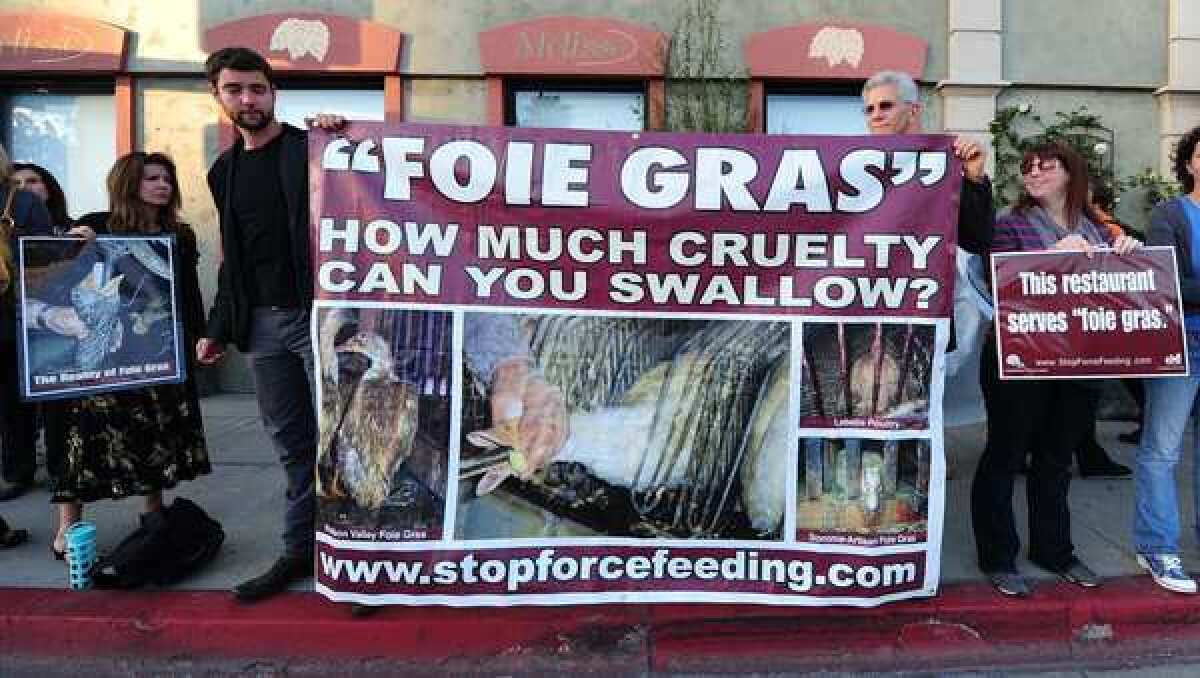With foie gras ban, chefs say state is force-feeding morality

If you want to eat foie gras in California before July 1, especially at a feast dedicated to the smooth, super-fatted duck liver, your pâté may be seasoned with a grain or two of political theater.
Outside Santa Monica’s Mélisse earlier this month, there were news trucks, a cordon of friendly police officers, protesters waving crumpled posters showing unhappy waterfowl and rumpled counter-protesters with their own propaganda fliers, dancing around the periphery like boxers waiting to get into the ring.
Inside the oddly subdued restaurant, between bites of foie gras-topped salmon and spoonfuls of foie gras mousse, diners at the benefit for the pro-foie gras lobbying group CHEFS discussed liberty and curtailed freedoms when they weren’t being distracted by the provenance of the Pinot Noir. Some of the waitresses modeled tight T-shirts printed with toque-wearing ducks and the slogan “touche pas à mon foie gras” (don’t touch my foie gras) . On them, it looked good.
Practically every night in June saw another multi-course foie gras menu staged in another famous restaurant — another succession of foie gras terrines with jelly and foie gras with grapes and pie crust; shaved frozen foie gras piled in drifts among the vegetables like so much duck-liver snow. Foie gras ice cream actually became a cliché. A new wave delicatessen got into the act with foie gras doughnuts.
Chefs have been selling foie gras like it’s going out of business. And in California it is.
On July 1, SB 1520, the bill that bans the production and sale of both foie gras and foie gras byproducts (including feathers for down jackets and comforters) goes into effect, and anybody wanting a legal taste of the stuff is going to have to do it in another state. After June 30, a restaurant that serves foie gras — typically produced via gavage, a process in which ducks or geese are fed through tubes inserted in their throats — can be fined up to $1,000.
That’s a lot of money to flout what is, in essence, a morals clause.
Which raises the question: In a period when New York Mayor Michael R. Bloombergpushed through a regulation banning supersize soda, California banned the sale of sharks’ fin soup and Supreme Court Justice Antonin Scalia asked whether the federal government could force an individual to buy broccoli, can kitchen morality be legislated? Do the ban’s largely vegan supporters see it as a first step toward a larger ban on meat? Does a prohibition on products obtained from over-fattened ducks and geese protect animals or erode liberties — or both?
“It’s not just foie gras,”’ says Josiah Citrin, the chef and owner of Mélisse. “Most people don’t eat [it], so they think it doesn’t have anything to do with them. The problem is, what’s the next step, chicken?”
Chef Rafael Lunetta, of Santa Monica’s JiRaffe, insists that the production of foie gras is not cruel. “The animal that is best treated on the farm is invariably the best animal for the plate,” he says. “If an animal is stressed out or mistreated, you can taste it.”
Will we soon see foie gras outlets pop up alongside the fireworks stands and discount cigarette houses at the state line in Nevada? Doubters should consider this: An itinerary for New York City foie gras tourism popped up in my email box last week.
I was thinking about the foie gras ban as I sat in a Canoga Park sushi bar recently, enjoying an omakase-style tasting menu that suddenly veered into a bluefin tuna course. When environmentalists talk about endangered oceans, bluefin, the largest and most majestic of tuna, is usually one of the fish they have in mind. Bluefin is at the very top of the ocean’s food chain — catching the fish could be compared to lowering a hook onto the Serengeti and pulling up lions. And, unfortunately, bluefin is both prized and extremely delicious — a single fish can end up going for more than $50,000 at the famous Tsukiji market in central Tokyo.
The population of Atlantic bluefin has plummeted more than 70% since 1970, and the only restraints on consumption are voluntary: Responsible chefs, such as Citrin and Michael Cimarusti at Los Angeles’ Providence, long ago took bluefin off their menus.
But Cimarusti, for one, does not make the leap from fish to fowl. “Our foie gras comes from a company that treats its animals with respect and dignity,’’ he says. “Or at least with as much respect and dignity as you can show an animal raised for slaughter. I have no qualms about serving it. But if I serve bluefin or Chilean sea bass, I am supporting the extinction of a species. There’s a huge difference.”
Other bans and boycotts have emerged with scant protest from chefs. California’s horse meat ban, passed by initiative with 59.4% of the vote in 1998, has been largely unremarked. Chefs hope that last year’s California ban on the sale and consumption of sharks’ fin will help slow the precipitous decline in that species’ numbers. Voluntary boycotts of Atlantic striped bass, swordfish and Chilean sea bass have helped those species recover, if only slightly. Beluga caviar from the Caspian Sea, once a mainstay on the sorts of menus that also feature foie gras, disappeared from United States menus after theU.S. Department of Agriculturebanned the import of products from the endangered sturgeon in 2005. (The ban has been partially lifted, but most American chefs have shifted to more sustainable domestic sources, such as paddlefish.)
But ducks and geese are not endangered — far from it. What is controversial is gavage, a practice dating to ancient Egypt in which waterfowl, in the last couple of weeks before slaughter, are fed through tubes inserted down their throats, a process that causes their livers to fatten and enlarge.
Opponents of foie gras, and there are many, see gavage as torture, an uncivilized process no animal should have to endure, and it is difficult for almost anybody to witness the sight of a steel pipe going down a duck’s throat without wincing.
Nonetheless, many chefs and farmers point out that waterfowl anatomy is different from human anatomy; that duck throats, evolved to withstand the rigors of swallowing fish many times the diameter of their necks, are leathery and resilient; that they have no gag reflex; and that the placement of their windpipes allows them to breathe easily even during the few seconds of the feeding.
“This is not Donald Duck,” says Lissa Doumani, who runs the St. Helena restaurant Terra with her husband, Hiro Sone. “As chefs, we’re always looking for sustainable, well-raised animals, and reliable, healthful ingredients — we’re responsible people. The effect of this law is to put one small farmer out of business and to put the government into our [kitchens]. The ban may not be of earth-moving importance — most people have never even tasted foie gras — but it is a freedom we’ve lost.”
It’s an expensive freedom. Sonoma Foie Gras, the only producer in California, charges $60 a pound for Grade A foie gras on its website. But not for long. Owner Guillermo Gonzalez has said he will close his business.
I still remember my first real encounter with the stuff, at the old Hotel de France in the provincial capital Auch, a restaurant, with two Michelin stars, that was considered the epicenter of grand Gascon cuisine. The restaurant was famous across France for its deep cellar of Madiran, the inky wine of the region, and for its many preparations of foie gras.
I remember especially a preparation of the classic salad frisée au lardons in which the traditional cubes of bacon had been replaced by tiny, crusty cubes of sautéed foie gras that burst into liquid essence when they crackled between your teeth; the day after that, I experienced the huge, cool slabs of foie gras at Michel Guerard, then considered the greatest restaurant in France, which were served unadorned save for a sprinkle of sea salt and a few slices of brioche grilled over wood.
It was glorious. It was not an experience from which I wanted to be saved.
That toro sushi in Canoga Park, made from the fatty belly of endangered bluefin, was also glorious. But the difference, I think, is clear.
More to Read
Eat your way across L.A.
Get our weekly Tasting Notes newsletter for reviews, news and more.
You may occasionally receive promotional content from the Los Angeles Times.







